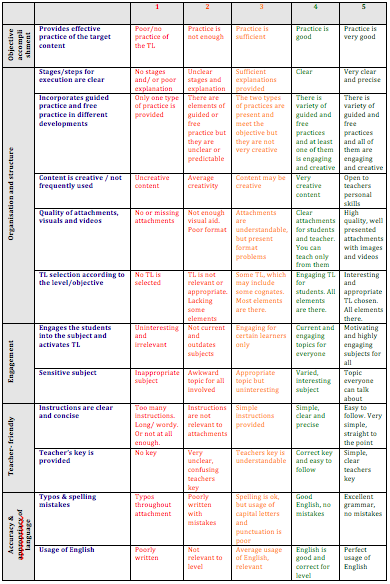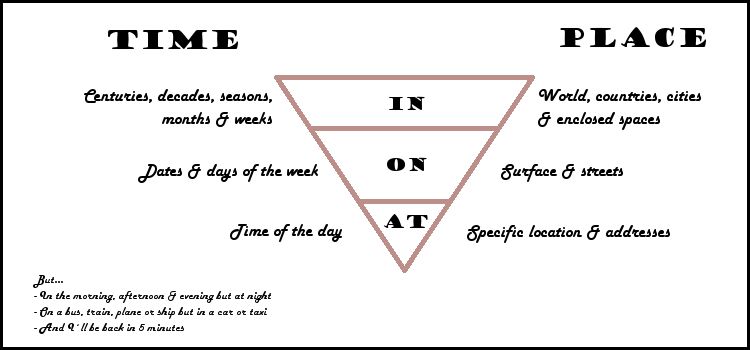Recently the Academy's teachers came together to discuss what they need to keep in mind when deciding their students'
proficiency levels in English and if advancement is warranted . The discussion was motivated by a lack of consensus on various students' levels and their progress. In a system where communication is prioritized and regular exams are missing, teachers will naturally differ in their opinions about students' language strengths and weaknesses. As a result, it is important to occasionally come together and reflect on what teachers should consider when determining proficiency levels in English. This was the first of many such conversations to follow.
To start off, we had a frank conversation about what each of us thinks about when determining if students are ready for the next step:
- Management of complex tenses
- Usage of auxiliaries
- Vocabulary
- Grammatical accuracy
- Fluency/speed in production
- Comprehension of material presented
- Pronunciation
- Confidence in production
- Retention of material covered
As you can see, there is quite a number of factors that must be considered. Which of these, then, should we prioritize and how do they apply to each level i.e. beginning through advanced levels. For brevity's sake, we will focus on three aspects at every level: vocabulary, grammatical accuracy and phonological control. The following lists contain a breakdown of what the teachers believe students should know prior to being allowed to move on a higher level.
|
VOCABULARY |
GRAMMATICAL ACCURACY |
PHONOLOGICAL CONTROL |
- Concrete objects that can be depicted through action of images
- Greetings and introductions
- Basic objects
- Simple verbs (to have/to take/to do/to be)
- Likes/dislikes
- Transportation and its various modes
|
- Simple tenses: past, present, future
- Basic modals
- Interrogative inversion, affirmative and negative sentence formation
|
- Comprehensible with some difficulty
- Minimal copying of Spanish sounds
|
|
- Time
- Directions
- Survival English
- Advanced adjectives
- Elaboration of likes/dislikes (hate, love, enjoy)
- Ordinal/cardinal numbers
- Routines related to work, like, hobbies, sports
- Simple phrasal verbs related to daily routine (to get up, to wake up, to put on etc)
|
- Future
- Continuous tenses
- Irregular verbs in the past
- Make v. do
- Usage of auxiliaries
- Prepositions
- Pronouns
- Nouns
- Mistakes are typically serious without much awareness and need guidance in correction
|
- More awareness of sounds
- Accent still strong but they are more understandable
|
|
- Jobs
- Travel
- Complex emotions
- Deeper expression of one’s professional life/field
|
- Conjunctions
- Complex sentences
- Conditionals
- Past continuous
- Fixed prepositions
- Tag questions
- Modals (present)
- Adverbs of frequency
- Errors are still moderately prevalent but there is more awareness and flagging usually leads to self-correction
|
- Word awareness
- Dipthongs
- Combination of words
- Grasp of mute letters
|
|
- Phrasal verbs
- Idiomatic expressions
- ESP vocabulary
- Abstract ideas/problems solving
- Colloquialism(s)
|
- Past modals
- Third/mixed conditionals
- All tenses well mastered
- More lapses in this case rather than errors or mistakes
- More usage of slang/colloquialisms in proper way
- Complex conjunctions
- Reported speech
- Passive voice
- Indirect questions
- Subjunctive
- Inversion for emphasis
|
- Intonation
- Convincing command of sounds
- Sentence stress is well mastered.
|
|
|
|
|
|
This is a great first step at creating a concrete rubric for proficiency at the various levels but there is still much to do. Though we feel empowered with information we also need the tools to help us effectively apply the rubric. In future sessions on the topi, we will more fully complete the chart, including the highest level P5, and develop the rubric that all teachers can rely on when assessing their students.
In the meantime, here are some resources to consult and remember to keep an eye on this page for updates!
More on CEFR levels:
British Council CEFR chart
Core inventory on CEFR. A complete compendium



